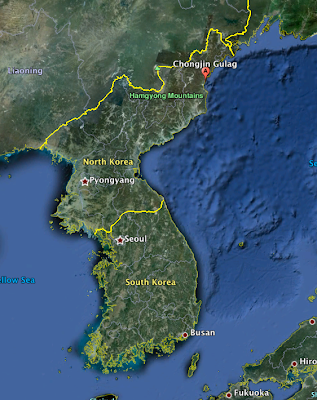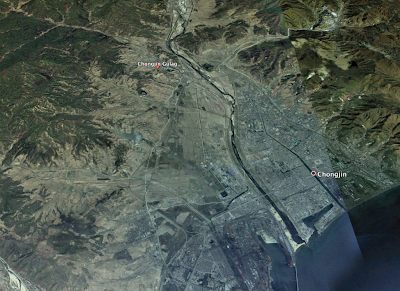A recent publication by the U.S. Committee for Human Rights in North Korea provides us with an update of North Korea's Political Prison Camp Number 22, one of North Korea's infamous prison camps. DigitalGlobe Analytics monitors activity at North Korean political prison camps in conjunction with the Committee for Human Rights in North Korea to shed light on the suffering in these camps.
DigitalGlobe Analytics examined images of Camp 25, also known as Kwan-li-so Number 25, collected between 2003 and 2013. This camp is located on the northeast coast of North Korea near Chongjin as shown on this Google Earth screen capture:
Here's a closer view showing the relationship between the Chongjin Gulag or Camp 25 and the city of Chongjin:
A White Paper by the Korean Bar Association (KBA) suggests that the camp holds 3000 "felons, religious leaders, spies and members of factions along with their families". Another report states that the camp holds only political criminals and not their families. The camp is operated by the Bowibu or North Korean National Security Agency or National Security Police.
The camp appears to consist of five main areas; administration, agricultural, light industrial, prisoner housing and other support. Gates, walls and fences separate the facility from the adjacent town. The main industries at the camp is the manufacture of bicycles using hand tools. There also appears to be a wood mill at this location.
Here is an unannotated satellite photo of the camp showing the presence of guard towers along the cleared security perimeter of the camp:
Over the years between 2003 and 2013, the camp has changed substantially, particularly after 2009. Before 2009, the camp had a perimeter of 3653 metres and an area of 565,424 square metres. In 2010, the camp expanded and now has a perimeter of 5046 metres and an area of 972,270 square metres, an increase of 72 percent.
In 2003, there were approximately 20 guard posts throughout the area of the camp. Two more were added in 2007, four more were added in 2009 and in 2010, an additional 17 guard posts were added mainly along the new perimeter.
Here's an annotated satellite photo of the camp from 2003 noting the guard towers in red:
Here's an annotated satellite photo of the camp from 2010 showing the dramatic expansion of the camp and the large number of new guard towers:
Here is an image from 2012 showing new buildings, walls and the expansion of roadways in the camp:
Here are two relatively new structures located in the far corner of the camp, near the camp perimeter:
Both buildings appear to be surrounded by earthen berms and at least five guard towers are located nearby. One can only guess at the intended use of these buildings, however, the could be a prison within a prison since they are located so far from the rest of the prison infrastructure yet they appear to be relatively heavily guarded.
Why did the camp expand? It would appear that North Korea was undergoing a transition among the elite as Kim Jong-il was attempting to ensure that his son Kim Jong-un would succeed him. As well, at the same time, there were increased efforts to stem the flood of defectors attempting to leave North Korea; those caught and returned from China would likely be imprisoned or executed. It also appears that another prison camp, Camp 22, may be undergoing a either a transformation or a closure, necessitating the transfer of prisoners from one camp to another.
Up to 200,000 people are believed to be imprisoned under horrible conditions in North Korea's gulag system and an estimated 400,000 have died in these camps. Many are imprisoned without due process, largely for alleged political crimes against the existing regime. While North Korea denies the existence of these work camps, a fascinating book by Shin In Guen, "Escape From Camp 14" certainly lends credence to what cannot be hidden from the global inventory of imaging satellites.
Click HERE to read more of Glen Asher's columns
You can publish this article on your website as long as you provide a link back to this page.








Be the first to comment